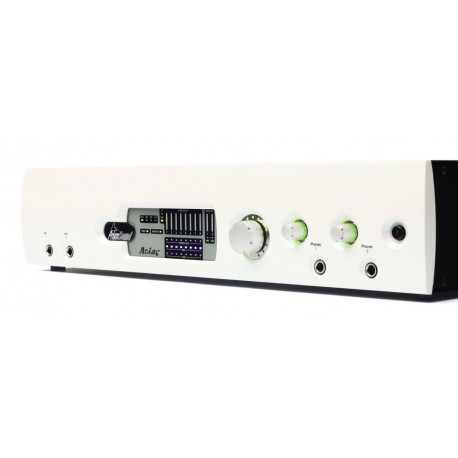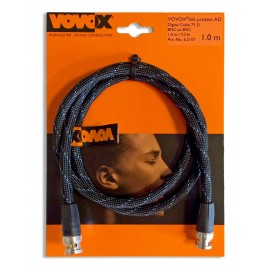No products
Prices are tax included
PRISMSOUND Atlas USB Recording Interface
Atlas USB Recording Interface with MDIO expansion
Overview
Atlas is a USB multi-track audio interface for personal recording and sound production, for professional musicians, songwriters, engineers and producers as well as recording studios, post production facilities and scoring stages.
Atlas is ideal for music and sound recording, mixing, multitracking, overdubbing, stem-based mastering, analogue summing and critical listening applications.Atlas provides Prism Sound's renowned performance, sound quality and state-of-the-art clock technology in a dedicated unit compatible with both Windows (Vista, 7 and 8, 32 and 64 bit, ASIO as well as MAC OS X 10.4.11 and later (Intel). Once configured with a computer, Atlas can also operate stand-alone using its ADAT, S/PDIF or AES3 I/O.
Signal path
Eight analogue input channels and up to 10 digital input channels are available as inputs for your audio workstation software through the host computer's audio driver. Similarly, eight analogue output channels, up to 10 digital output channels and stereo headphone outputs can play 20 different channels. For low-latency foldback or monitoring to headphones or main outputs, each output pair (1-2, 3-4 etc or the headphone output) can optionally be driven from the built-in DSP mixer with an individual local mix of any selection of inputs through the controller applet. All analogue inputs are electronically balanced with automatic unbalanced operation. Analogue outputs are electronically balanced with 'bootstrapping', i.e. level is maintained if one leg is grounded.
Multichannel Digital Input and Output (MDIO) expansion
As well as the built-in inputs and outputs Atlas can accommodate other optional digital interfaces such as Pro Tools | HDX and AES3 multichannel options through its MDIO expansion slot. This flexibility makes Atlas perfectly suitable for the home, native or project studio as well as larger multitracking facilities by seamless, reliable integration with the industry standard platforms. The MDIO expansion means Atlas is future-proof allowing further digital interface options to be developed and available such as Thunderbolt (to be confirmed).
No-compromise, full Prism Sound audio quality
Atlas makes no compromises on audio quality. It is the result of years of research and development into digital audio conversion and extensive dialogue with Prism Sound's customers. Atlas draws on Prism Sound's years of experience in developing digital audio products, including its range of audio test equipment, adopted by a wide variety of clients across the audio industry from pro-audio to consumer electronics. This experience means that Atlas is well-behaved both as a computer peripheral and an audio processor. Reliability is vitally important in professional recording. Prism Sound has always made extensive use of precise software calibration techniques in its converters - pots and tweaks are always unreliable, so there are none. The design team has gone to great lengths to minimise noise and interference, in particular hum. All of the analogue circuits have galvanic isolation, while the unit's electronically balanced I/O allows it to handle common mode interference sources as well as enabling trouble-free connection to unbalanced equipment. It is often said that THD+N figures do not always correlate well with the perception of sound quality and this is true - partly because the traditional measures of THD+N or SINAD expressed as RMS figures are rather a broad measure. With this in mind, we have taken great care to make sure that not only is the Atlas noise and distortion spectrum beyond reproach, but the RMS distortion result measures up to the state of the art.
Atlas in Brief:
-
- No-compromise, full Prism Sound audio quality
- Dedicated USB interface
- Multichannel Digital I/O (MDIO) expansion port
- ASIO drivers provided for Windows VISTA, 7 and 8 (32 and 64bit)
- Directly compatible with CORE AUDIO on Mac OS X 10.4+
- Eight "Prism Sound" premium-quality AD and DA channels
- Concurrent operation of ADAT and switchable S/PDIF or AES3 ports
- Eight high-end integrated mic preamps (typ.-130dBu EIN)
- Mic pres have individually switchable phantom power and 20dB pads
- MS Matrix processing on mic inputs
- Two instrument inputs
- RIAA Equalization on inputs 1 & 2
- Prism Sound "Overkillers" on every analogue channel to control transient overloads
- Fully-floating (isolated) balanced architecture for optimum noise rejection
- Mono or stereo input configurations
- Outputs selectable between workstation bus or Atlas mixer
- Low-latency "console-quality" digital mixer for foldback monitoring
- Fader, pan, cut, solo on every mixer channel
- Dual headphone outputs each with its own front-panel volume control
- Front-panel master volume control and mute, assignable to selected channels
- Configurable for stereo, 5.1 or 7.1 or surround monitoring
- Built-in sample rate conversion (SRC) on S/PDIF Inputs and Outputs
- Prism Sound 4-curve SNS noise shaping on digital outputs
- State-of-the-art clock generation with proprietary hybrid 2-stage DPLL
FRONT PANNEL
| Instrument Inputs | 2 x 6.3mm mono jack sockets, auto-select to analogue inputs 1 & 2 when plugged |
| Headphone Outputs | 2 x 6.3mm stereo TRS Jacks, each with illuminated volume control |
| Master volume | Assignable encoder / push switch with halo indication |
| Standby button | with standby indicator (also flashes when unit is in 'identify' mode) |
| Indication: | |
| Level Meters | 10 x multi-segment bargraphs with overload indication, 8 for analogue, 2 for digital, assignable to inputs or outputs |
| Input selection | Indicate mode of analogue inputs 1-8 as Mic / line / inst with phantom power indication for mic mode |
| Overkiller | For every analogue input, lit when Overkiller limiters are acting |
| Digital Input | indicators for digital input unlocked and SRC (sample-rate converter) selected |
| Digital Output | indicator for SRC (sample-rate converter) selected |
| Sync | Master indicator, lit when interface is providing system sync |
REAR PANNEL
| Mic / Line inputs | 8 x combo connectors with XLR sockets for mic input and 6.3mm TRS jack sockets for line input (balanced or unbalanced) |
| Line outputs | 8 x 6.3mm TRS jack sockets (balanced or unbalanced) |
| Digital inputs | 1 x RCA 1 x TOSLINK for S/PDIF or ADAT Optical input; (RCA can operate as AES3 input using XLR-RCA adapter supplied) |
| Digital output | 1 x RCA 1 x TOSLINK for S/PDIF or ADAT Optical output; (RCA can operate as AES3 output using XLR-RCA adapter supplied) |
| MIDI I/O | 2 x 5 Pin DIN sockets (in and out) |
| Wordclock | 2 x BNC sockets, output and input (75R) |
| USB port | 1 x USB 2 port |
| Ethernet port | For future expansion / AVB |
| MDIO Expansion Slot | For alternative digital multi-channel I/O |
| Mains power | 3-pin 6A IEC inlet |








